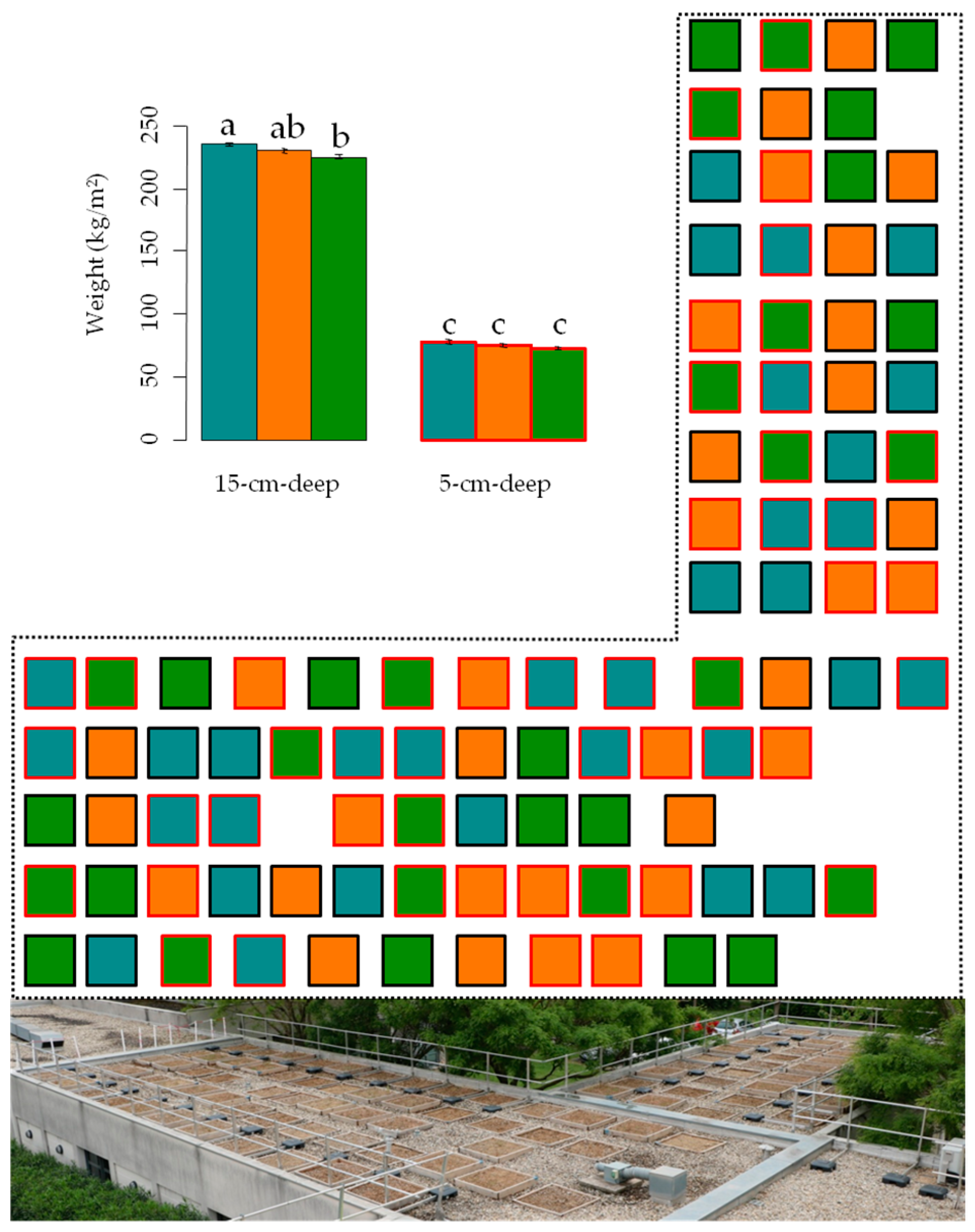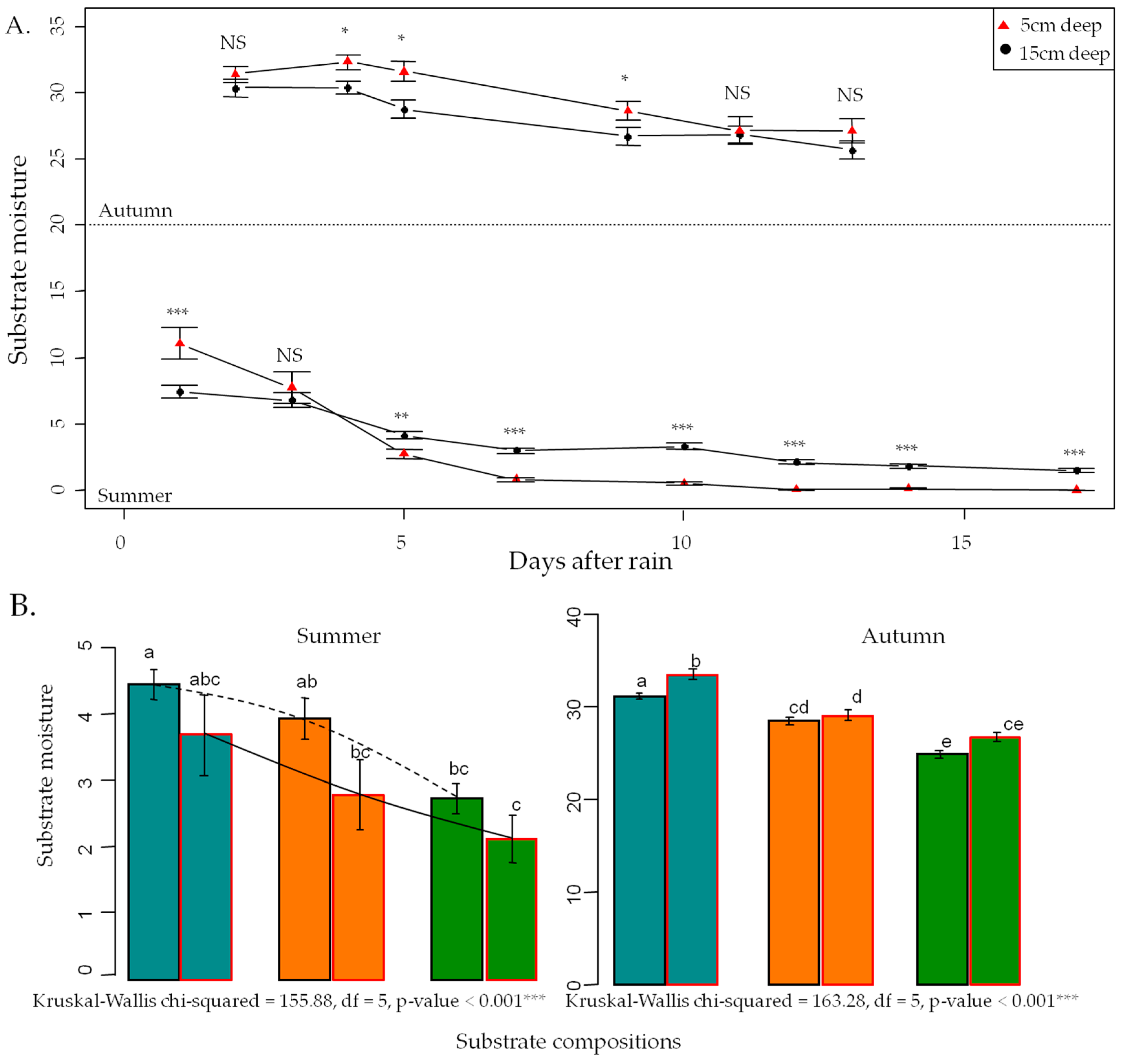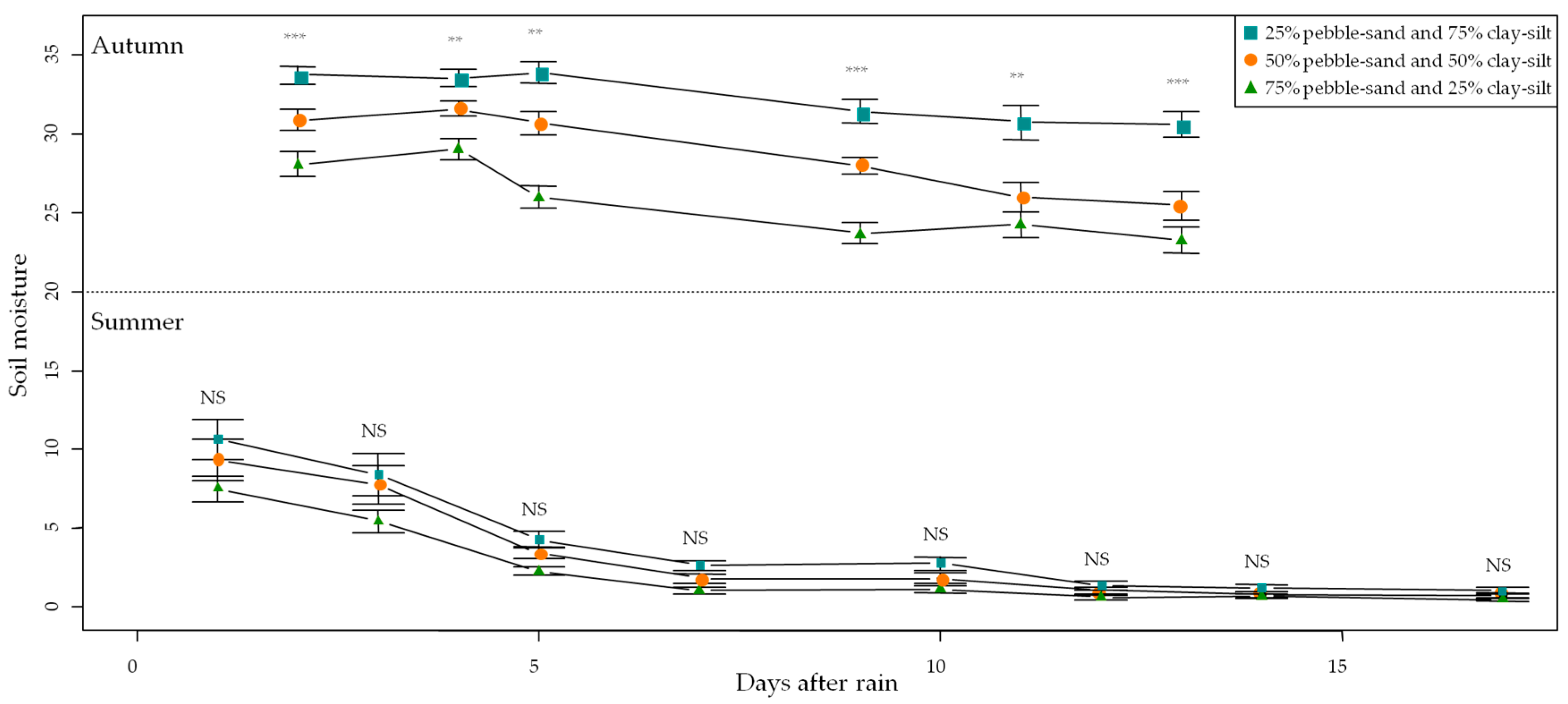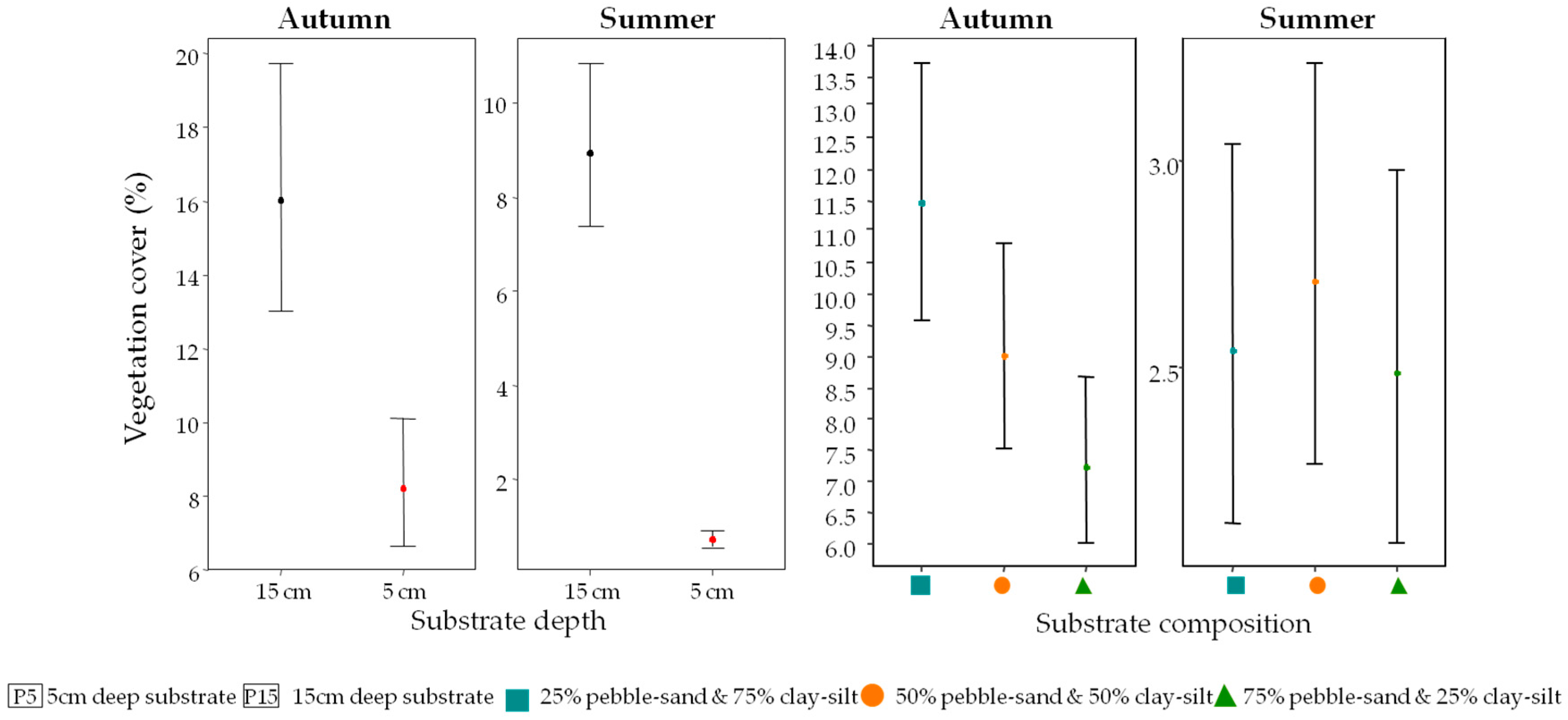Substrate Composition and Depth Affect Soil Moisture Behavior and Plant-Soil Relationship on Mediterranean Extensive Green Roofs
Abstract
:1. Introduction
2. Materials and Methods
2.1. Study Site Location
2.2. Climate and Soil Moisture
2.3. Experimental Protocol
2.4. Substrate Moisture Measurement and Rainfall Monitoring
2.5. Statistical Analysis
3. Results
3.1. Influence of the Different Variables Measured on Substrate Moisture
3.2. Effect of Substrate Depth on Substrate Moisture
3.3. Effet of Substrate Composition on Substrate Moisture
3.4. Effet of Vegetation Cover on Substrate Moisture
4. Discussion
5. Conclusions
Acknowledgments
Author Contributions
Conflicts of Interest
References
- Perring, M.P.; Manning, P.; Hobbs, R.J.; Lugo, A.E.; Ramalho, C.E.; Standish, R.J. Novel Urban Ecosystems and Ecosystem Services. In Novel Ecosystems; Hobbs, R.J., Higgs, E.S., Hall, C.M., Eds.; John Wiley & Sons Ltd.: Hoboken, NJ, USA, 2013; pp. 310–325. ISBN 978-1-118-35418-6. [Google Scholar]
- Dvorak, B.; Volder, A. Green roof vegetation for North American ecoregions: A literature review. Landsc. Urban Plan. 2010, 96, 197–213. [Google Scholar] [CrossRef]
- Fioretti, R.; Palla, A.; Lanza, L.G.; Principi, P. Green roof energy and water related performance in the Mediterranean climate. Build. Environ. 2010, 45, 1890–1904. [Google Scholar] [CrossRef]
- Groenewegen, P.P.; van den Berg, A.E.; de Vries, S.; Verheij, R.A. Vitamin G: Effects of green space on health, well-being, and social safety. BMC Public Health 2006, 6, 149. [Google Scholar] [CrossRef] [PubMed]
- Oberndorfer, E.; Lundholm, J.; Bass, B.; Coffman, R.R.; Doshi, H.; Dunnett, N.; Gaffin, S.; Köhler, M.; Liu, K.K.Y.; Rowe, B. Green Roofs as Urban Ecosystems: Ecological Structures, Functions, and Services. BioScience 2007, 57, 823–833. [Google Scholar] [CrossRef]
- White, E.V.; Gatersleben, B. Greenery on residential buildings: Does it affect preferences and perceptions of beauty? J. Environ. Psychol. 2011, 31, 89–98. [Google Scholar] [CrossRef] [Green Version]
- Brenneisen, S. Space for urban wildlife: Designing green roofs as habitats in Switzerland. Urban Habitats 2006, 4, 27–36. [Google Scholar]
- Madre, F.; Vergnes, A.; Machon, N.; Clergeau, P. A comparison of 3 types of green roof as habitats for arthropods. Ecol. Eng. 2013, 57, 109–117. [Google Scholar] [CrossRef]
- Kowarik, I. Novel urban ecosystems, biodiversity, and conservation. Environ. Pollut. 2011, 159, 1974–1983. [Google Scholar] [CrossRef] [PubMed]
- Madre, F.; Vergnes, A.; Machon, N.; Clergeau, P. Green roofs as habitats for wild plant species in urban landscapes: First insights from a large-scale sampling. Landsc. Urban Plan. 2014, 122, 100–107. [Google Scholar] [CrossRef]
- Cook-Patton, S.C.; Bauerle, T.L. Potential benefits of plant diversity on vegetated roofs: A literature review. J. Environ. Manag. 2012, 106, 85–92. [Google Scholar] [CrossRef] [PubMed]
- Soulis, K.X.; Ntoulas, N.; Nektarios, P.A.; Kargas, G. Runoff reduction from extensive green roofs having different substrate depth and plant cover. Ecol. Eng. 2017, 102, 80–89. [Google Scholar] [CrossRef]
- Brudermann, T.; Sangkakool, T. Green roofs in temperate climate cities in Europe—An analysis of key decision factors. Urban For. Urban Green. 2017, 21, 224–234. [Google Scholar] [CrossRef]
- Farrell, C.; Ang, X.Q.; Rayner, J.P. Water-retention additives increase plant available water in green roof substrates. Ecol. Eng. 2013, 52, 112–118. [Google Scholar] [CrossRef]
- Vanuytrecht, E.; Van Mechelen, C.; Van Meerbeek, K.; Willems, P.; Hermy, M.; Raes, D. Runoff and vegetation stress of green roofs under different climate change scenarios. Landsc. Urban Plan. 2014, 122, 68–77. [Google Scholar] [CrossRef]
- Benvenuti, S.; Bacci, D. Initial agronomic performances of Mediterranean xerophytes in simulated dry green roofs. Urban Ecosyst. 2010, 13, 349–363. [Google Scholar] [CrossRef]
- Rowe, D.B.; Getter, K.L.; Durhman, A.K. Effect of green roof media depth on Crassulacean plant succession over seven years. Landsc. Urban Plan. 2012, 104, 310–319. [Google Scholar] [CrossRef]
- Thuring, C.E.; Berghage, R.D.; Beattie, D.J. Green Roof Plant Responses to Different Substrate Types and Depths under Various Drought Conditions. HortTechnology 2010, 20, 395–401. [Google Scholar]
- Young, T.; Cameron, D.D.; Sorrill, J.; Edwards, T.; Phoenix, G.K. Importance of different components of green roof substrate on plant growth and physiological performance. Urban For. Urban Green. 2014, 13, 507–516. [Google Scholar] [CrossRef]
- Banting, D.; Doshi, H.; Li, J.; Missios, P. Report on the Environmental Benefits and Costs of Green Roof Technology for the City of Toronto; City of Toronto and Ontario Centres for Excellence—Earth and Environmental Technologies; Ryerson University: Toronto, ON, Canada, 2005; p. 88. [Google Scholar]
- Water Scarcity in the Mediterranean: Perspectives under Global Change; Sabater, S.; Barceló, D. (Eds.) The Handbook of Environmental Chemistry; Springer: Heidelberg, Germany; New York, NY, USA, 2010; ISBN 978-3-642-03970-6. [Google Scholar]
- Van Mechelen, C.; Dutoit, T.; Kattge, J.; Hermy, M. Plant trait analysis delivers an extensive list of potential green roof species for Mediterranean France. Ecol. Eng. 2014, 67, 48–59. [Google Scholar] [CrossRef]
- Li, W.C.; Yeung, K.K.A. A comprehensive study of green roof performance from environmental perspective. Int. J. Sustain. Built Environ. 2014, 3, 127–134. [Google Scholar] [CrossRef]
- Dunnett, N.; Kingsbury, N. Planting Green Roofs and Living Walls; Timber Press: Portland, OR, USA, 2004; ISBN 978-0-88192-640-8. [Google Scholar]
- Getter, K.L.; Rowe, D.B. The Role of Extensive Green Roofs in Sustainable Development. HortScience 2006, 41, 1276–1285. [Google Scholar]
- Pledge, E. Green Roofs: Ecological Design and Construction; Schiffer Publishing: Atglen, PA, USA, 2005; ISBN 978-0-7643-2189-4. [Google Scholar]
- Snodgrass, E.C.; Snodgrass, L.L. Green Roof Plants: A Resource and Planting Guide; Timber Press: Portland, OR, USA, 2006; ISBN 978-0-88192-787-0. [Google Scholar]
- Hill, J.; Drake, J.; Sleep, B. Comparisons of extensive green roof media in Southern Ontario. Ecol. Eng. 2016, 94, 418–426. [Google Scholar] [CrossRef]
- Nagase, A.; Dunnett, N. The relationship between percentage of organic matter in substrate and plant growth in extensive green roofs. Landsc. Urban Plan. 2011, 103, 230–236. [Google Scholar] [CrossRef]
- FLL e.V. Guidelines for the Planning Construction and Maintenance of Green Roofing—Green Roofing Guideline; FLL e.V.: Bonn, Germany, 2008. [Google Scholar]
- Getter, K.L.; Bradley Rowe, D.; Cregg, B.M. Solar radiation intensity influences extensive green roof plant communities. Urban For. Urban Green. 2009, 8, 269–281. [Google Scholar] [CrossRef]
- Catalano, C.; Marcenò, C.; Laudicina, V.A.; Guarino, R. Thirty years unmanaged green roofs: Ecological research and design implications. Landsc. Urban Plan. 2016, 149, 11–19. [Google Scholar] [CrossRef]
- Catalano, C.; Guarino, R.; Brennseisen, S. A plant sociological approach for extensive green roofs in Mediterranean areas. In Proceedings of the 11th Annual CitiesAlive Green Roof and Wall Conference is Securing Urban Resiliency with Living Architecture, San Francisco, CA, USA, 23–26 October 2013. [Google Scholar]
- Allison, G. The Influence of Species Diversity and Stress Intensity on Community Resistance and Resilience. Ecol. Monogr. 2004, 74, 117–134. [Google Scholar] [CrossRef]
- Nagase, A.; Dunnett, N. Establishment of an annual meadow on extensive green roofs in the UK. Landsc. Urban Plan. 2013, 112, 50–62. [Google Scholar] [CrossRef]
- Baize, D.; Jabiol, B. Guide Pour la Description Des Sols; Éd. Quae: Versailles, France, 2011; ISBN 978-2-7592-1034-3. [Google Scholar]
- Nofal, S. Étude du Fonctionnement Hydrodynamique de la Nappe Alluviale d’Avignon: Impact de L’usage du sol sur les Mécanismes de Recharge. Ph.D. Thesis, Université d’Avignon, Avignon, France, 2014. [Google Scholar]
- Riser, J. Les Espaces du vent; Quae: Versailles, France, 2010; ISBN 978-2-7592-1225-5. [Google Scholar]
- Celle, H. Caractérisation des Précipitations sur le Pourtour de la Méditerranée Occidentale: Approche Isotopique et Chimique. Ph.D. Thesis, Université d’Avignon, Avignon, France, 2000. [Google Scholar]
- Huneau, F. Fonctionnement Hydrogéologique et Archives Paléoclimatiques d’un Aquifère Profond Méditerranéen: Étude Géochimique et Isotopique du Bassin Miocène de Valréas (Sud-Est de la France). Ph.D. Thesis, Université d’Avignon, Avignon, France, 2000. [Google Scholar]
- Berretta, C.; Poë, S.; Stovin, V. Moisture content behaviour in extensive green roofs during dry periods: The influence of vegetation and substrate characteristics. J. Hydrol. 2014, 511, 374–386. [Google Scholar] [CrossRef]
- Graceson, A.; Monaghan, J.; Hall, N.; Hare, M. Plant growth responses to different growing media for green roofs. Ecol. Eng. 2014, 69, 196–200. [Google Scholar] [CrossRef]
- Hermy, M.; Schauvliege, M.; Tijskens, G. Groenbeheer, een Verhaal met Toekomst; Velt: Berchem, Belgium, 2005; ISBN 978-90-806622-2-3. [Google Scholar]
- Thomas, G.W. Soil pH and Soil Acidity. In Methods of Soil Analysis Part 3—Chemical Methods; Sparks, D.L., Page, A.L., Helmke, P.A., Loeppert, R.H., Soltanpour, P.N., Tabatabai, M.A., Johnston, C.T., Sumner, M.E., Eds.; Soil Science Society of America Book Series; American Society of Agronomy: Madison, WI, USA, 1996; Volume 5, pp. 475–490. [Google Scholar]
- Sparks, D.L.; Page, A.L.; Helmke, P.A.; Loeppert, R.H.; Soltanpour, P.; Tabatabai, M.A.; Johnston, C.T.; Sumner, M.E. Methods of Soil Analysis. Part 3—Chemical Methods; American Society of Agronomy: Madison, WI, USA, 1996; p. 1390. [Google Scholar]
- Allison, L.E. Organic carbon. In Methods of Soil Analysis; Black, C.A., Evans, D.D., White, J.L., Enisminger, L.E., Clark, F.E., Eds.; American Society of Agronomy: Madison, WI, USA, 1965; pp. 1372–1378. [Google Scholar]
- Bremner, J.M. Nitrogen-Total. In Methods of Soil Analysis. Part 3—Chemical Methods; Sparks, D.L., Page, A.L., Helmke, P.A., Loeppert, R.H., Soltanpour, P.N., Tabatabai, M.A., Johnston, C.T., Sumner, M.E., Eds.; Soil Science Society of America Book Series; American Society of Agronomy: Madison, WI, USA, 1996; Volume 5, pp. 1085–1121. [Google Scholar]
- Dumas, J. Procédés de l’analyse organique. Ann. Chem. Phys. 1831, 47, 198–213. [Google Scholar]
- Metson, A.J. Methods of Chemical Analysis for Soil Survey Samples; New Zealand Department of Scientific and Industrial Research: Wellington, New Zealand, 1956.
- Ciesielski, H.; Sterckeman, T.; Santerne, M.; Willery, J.P. A comparison between three methods for the determination of cation exchange capacity and exchangeable cations in soils. Agron. Sustain. Dev. 1997, 17, 9–16. [Google Scholar] [CrossRef]
- Olsen, S.R. Estimation of Available Phosphorus in Soils by Extraction with Sodium Bicarbonate; US Department of Agriculture: Washington, DC, USA, 1954.
- Bonferroni, C.E. Teoria statistica delle classi e calcolo delle probabilità. Pubbl. R Ist. Super. Sci. Econ. E Commer. Firenze 1936, 8, 3–62. [Google Scholar]
- Rieux, R.; Ritschel, G.; Roux, C. Etude écologique et phytosociologique du Crassuletum tillaeae Molinier et tallon 1949. Rev. Biol. Décologie Méditerranéenne 1977, 4, 117–143. [Google Scholar]
- Coiffait-Gombault, C. Règles D’assemblages et Restauration Écologique des Communautés Végétales Herbacées Méditerranéennes: Le Cas de la Plaine de La Crau (Bouches-du-Rhône, France). Ph.D. Thesis, Université d’Avignon, Avignon, France, 2011. [Google Scholar]
- Badan, O.; Congés, G.; Brun, J.-P. Les bergeries romaines de la Crau d’Arles. Les origines de la transhumance en Provence. Gallia 1995, 52, 263–310. [Google Scholar] [CrossRef]
- Cherel, O. Contribution à L’étude des Relations Végétation-Mouton sur les Parcours de Crau (S.E. France): Adaptation et Développement de Méthodes d’Étude du Régime Alimentaire. Ph.D. Thesis, Université Aix Marseille 1, Marseille, France, 1988. [Google Scholar]
- Henry, F. Origine et Dynamique à Long Terme d’un Écosystème Herbacé Pseudo Steppique, le Cas de la Plaine de La Crau (Bouches du Rhône, France). Ph.D. Thesis, Université Paul-Cézanne, Marseille, France, 2009. [Google Scholar]
- Molinier, R.; Tallon, G. La Végétation de la Crau (Basse-Provence); Librairie générale De L’enseignement: Paris, France, 1950. [Google Scholar]
- Gomila, H. Relation Sol-Végétation Dans la Plaine de Crau (sud-est de la France); Aix-Marseille III University: Marseille, France, 1987. [Google Scholar]
- Buisson, E.; Jaunatre, R.; Römermann, C.; Bulot, A.; Dutoit, T. Seed bank studies in Mediterranean grassland: Lessons learnt from restoration projects. Restor. Ecol. 2017. in preparation. [Google Scholar]
- AT Delta-T Devices Ltd. ML3 ThetaProbe. Soil Moisture an Temperature Sensor. Quick Start Guide, version 1.0; AT Delta-T Devices Ltd.: Cambridge, UK, 2013. [Google Scholar]
- Thornthwaite, C.W. An Approach toward a Rational Classification of Climate. Geogr. Rev. 1948, 38, 55–94. [Google Scholar] [CrossRef]
- Coelho, R.; Infante, P.; Santos, M.N. Application of Generalized Linear Models and Generalized Estimation Equations to model at-haulback mortality of blue sharks captured in a pelagic longline fishery in the Atlantic Ocean. Fish. Res. 2013, 145, 66–75. [Google Scholar] [CrossRef]
- McCullagh, P. Generalized linear models. Eur. J. Oper. Res. 1984, 16, 285–292. [Google Scholar] [CrossRef]
- Yardin, C. Estimer la droite d’étalonnage avec les moindres carrés généralisés et évaluer le résultat de mesure. Rev. Fr. Métrol. 2013, 21–39. [Google Scholar] [CrossRef]
- Zuur, A.F.; Ieno, E.N.; Walker, N.; Saveliev, A.A.; Smith, G.M. Mixed Effects Models and Extensions in Ecology with R; Statistics for Biology and Health; Springer: New York, NY, USA, 2009; ISBN 978-0-387-87457-9. [Google Scholar]
- Burnham, K.P.; Anderson, D.R. Multimodel Inference: Understanding AIC and BIC in Model Selection. Sociol. Methods Res. 2004, 33, 261–304. [Google Scholar] [CrossRef]
- R Development Core Team. R: A Language and Environment for Statistical Computing. Reference Index; R Foundation for Statistical Computing: Vienna, Austria, 2016; p. 3501. [Google Scholar]
- Pinheiro, J.; Bates, D.; DebRoy, S.; Sarkar, D. Package “nlme”: Linear and Nonlinear Mixed Effects Models, R Package Version 31-131; 2017, p. 336. Available online: https://cran.r-project.org/web/packages/nlme/index.html (accessed on 25 October 2017).
- Bates, D.; Maechler, M.; Bolker, B.; Walker, S.; Christensen, R.H.B.; Singmann, H.; Dai, B.; Grothendieck, G.; Green, P. Package “lme4”: Linear Mixed-Effects Models Using ‘Eigen’ and S4, R Package Version 11-12; 2016, p. 113. Available online: http://keziamanlove.com/wp-content/uploads/2015/04/StatsInRTutorial.pdf (accessed on 25 October 2017).
- Palla, A.; Gnecco, I.; Lanza, L.G. Hydrologic Restoration in the Urban Environment Using Green Roofs. Water 2010, 2, 140–154. [Google Scholar] [CrossRef]
- Poë, S.; Stovin, V.; Berretta, C. Parameters influencing the regeneration of a green roof’s retention capacity via evapotranspiration. J. Hydrol. 2015, 523, 356–367. [Google Scholar] [CrossRef]
- Durhman, A.K.; Rowe, D.B.; Rugh, C.L. Effect of Substrate Depth on Initial Growth, Coverage, and Survival of 25 Succulent Green Roof Plant Taxa. HortScience 2007, 42, 588–595. [Google Scholar]
- Douguedroit, A. Le rôle de l’humidité des sols dans l’opposition de la végétation entre adrets et ubacs. Bull. Assoc. Géogr. Fr. 1974, 51, 133–140. [Google Scholar] [CrossRef]
- Tisdall, J.M.; Oades, J.M. Organic matter and water-stable aggregates in soils. J. Soil Sci. 1982, 33, 141–163. [Google Scholar] [CrossRef]
- Hettenbergerová, E.; Hájek, M.; Zelený, D.; Jiroušková, J.; Mikulášková, E. Changes in species richness and species composition of vascular plants and bryophytes along a moisture gradient. Preslia Čas. Čes. Bot. Spol. 2013, 85, 369–388. [Google Scholar]
- Smith, A.J.E. Bryophyte Ecology; Springer Science & Business Media: New York, NY, USA; Chapman and Hall: London, UK; New York, NY, USA, 1982; ISBN 978-94-009-5891-3. [Google Scholar]
- Crosaz, Y. Lutte Contre L’érosion des Terres Noires en Montagne Méditerranéenne. Connaissance du Matériel Végétal Herbacé et Quantification de son Impact sur L’érosion. Ph.D. Thesis, Université de Droit, D’économie et des Sciences—Aix-Marseille III, Marseille, France, 1995. [Google Scholar]
- Getter, K.L.; Rowe, D.B. Media depth influences Sedum green roof establishment. Urban Ecosyst. 2008, 11, 361. [Google Scholar] [CrossRef]
- Berghage, R.D.; Jarrett, A.; Beattie, D.J.; Kelley, K.; Husain, S.; Rezai, F.; Long, B.; Negassi, A.; Cameron, R.; Hunt, W. Quantifying Vvaporation and Transpirational Water Losses from Green Roofs and Green Roof Media Capacity for Neutralizing Acid Rain; The Pennsylvania State University: State College, PA, USA, 2007; p. 94. [Google Scholar]
- Stovin, V.; Poë, S.; De-Ville, S.; Berretta, C. The influence of substrate and vegetation configuration on green roof hydrological performance. Ecol. Eng. 2015, 85, 159–172. [Google Scholar] [CrossRef]
- Faurie, C. Ecologie: Approche Scientifique et Pratique; Lavoisier: Paris, France, 2011; ISBN 978-2-7430-1310-3. [Google Scholar]
- UNICEM. Statistiques 2015. Union Nationale des Industries de Carrières et Matériaux de Construction; UNICEM: Paris, France, 2017. [Google Scholar]






| Depth (cm) | Coarse Materials (%) | Fine Materials (Clay-Silt) (%) | Compost (% of Total Substrate Volume) | Number of Quadrats |
|---|---|---|---|---|
| 5 | 75 | 25 | 3 | 16 |
| 15 | 75 | 25 | 3 | 16 |
| 5 | 50 | 50 | 3 | 16 |
| 15 | 50 | 50 | 3 | 16 |
| 5 | 25 | 75 | 3 | 16 |
| 15 | 25 | 75 | 3 | 16 |
| Generalized Linear Model | AIC | Resid.Dev. | Resid.Df |
|---|---|---|---|
| moisture~Survey_date*composition*depth-date:composition:depth+vegetation cover | 3292.4 | 9824.1 | 565 |
| moisture~Survey_date*composition*depth-date:composition:depth | 3293.9 | 9882.8 | 566 |
| moisture~Survey_date*composition*depth+vegetation cover | 3293.2 | 9769.5 | 565 |
| Generalized Least Squares | |||
| log(moisture+1)~Survey_date*composition*depth-date:composition:depth | 1053.6 | 0.7220518 | 758 |
| log(moisture+1)~Survey_date*composition*depth-date:composition:depth+vegetation cover | 1057.8 | 0.7231789 | 757 |
| log(moisture+1)~Survey_date*composition*depth+vegetation cover | 1067.5 | 0.7276123 | 755 |
| Parameters | Df | Deviance | Resid. Df. | Resid. Dev | F-Value | p-Value |
|---|---|---|---|---|---|---|
| Generalized Linear Model—Autumn data | ||||||
| NULL | 575 | 16,662.2 | ||||
| Survey date | 1 | 2071.5 | 574 | 14,590.7 | 119.13 | <0.0001 *** |
| Composition | 2 | 4162.4 | 572 | 10,428.3 | 119.70 | <0.0001 *** |
| Depth | 1 | 360.5 | 571 | 10,067.8 | 20.73 | <0.0001 *** |
| Vegetation cover | 1 | 75.2 | 570 | 9992.6 | 4.32 | 0.038 * |
| Survey date:Composition | 2 | 92.1 | 568 | 9900.4 | 2.65 | 0.07 |
| Survey date:Depth | 1 | 9.5 | 567 | 9890.9 | 0.55 | 0.46 |
| Composition:Depth | 2 | 83.3 | 566 | 9824.1 | 1.92 | 0.15 |
| Generalized Least Squares—Summer data | ||||||
| (Intercept) | 1 | - | - | - | 1015.58 | <0.0001 *** |
| Survey date | 1 | - | - | - | 215.99 | <0.0001 *** |
| Composition | 2 | - | - | - | 43.43 | <0.0001 *** |
| Depth | 1 | - | - | - | 633.83 | <0.0001 *** |
| Survey date:Composition | 2 | - | - | - | 10.19 | <0.0001 *** |
| Survey date:Depth | 1 | - | - | - | 7.13 | 0.0077 * |
| Composition:Depth | 2 | - | - | - | 19.24 | <0.0001 *** |
| Parameters | Df | Deviance | Resid. Df. | Resid. Dev | p-Value |
|---|---|---|---|---|---|
| Generalized Linear Model, negative binomial model | |||||
| NULL | 1343 | 2185.2 | |||
| Depth | 1 | 258.713 | 1342 | 1926.5 | <0.0001 *** |
| Composition | 2 | 10.986 | 1340 | 1915.5 | <0.01 * |
| Season | 1 | 235.183 | 1339 | 1680.3 | <0.0001 *** |
| Composition: Season | 2 | 23.413 | 1337 | 1656.9 | <0.0001 *** |
| Composition: Depth | 2 | 40.081 | 1335 | 1616.8 | <0.0001 *** |
| Season: Depth | 1 | 153.233 | 1334 | 1463.6 | <0.0001 *** |
© 2017 by the authors. Licensee MDPI, Basel, Switzerland. This article is an open access article distributed under the terms and conditions of the Creative Commons Attribution (CC BY) license (http://creativecommons.org/licenses/by/4.0/).
Share and Cite
Chenot, J.; Gaget, E.; Moinardeau, C.; Jaunatre, R.; Buisson, E.; Dutoit, T. Substrate Composition and Depth Affect Soil Moisture Behavior and Plant-Soil Relationship on Mediterranean Extensive Green Roofs. Water 2017, 9, 817. https://doi.org/10.3390/w9110817
Chenot J, Gaget E, Moinardeau C, Jaunatre R, Buisson E, Dutoit T. Substrate Composition and Depth Affect Soil Moisture Behavior and Plant-Soil Relationship on Mediterranean Extensive Green Roofs. Water. 2017; 9(11):817. https://doi.org/10.3390/w9110817
Chicago/Turabian StyleChenot, Julie, Elie Gaget, Cannelle Moinardeau, Renaud Jaunatre, Elise Buisson, and Thierry Dutoit. 2017. "Substrate Composition and Depth Affect Soil Moisture Behavior and Plant-Soil Relationship on Mediterranean Extensive Green Roofs" Water 9, no. 11: 817. https://doi.org/10.3390/w9110817





